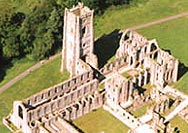![]() The
monastic revival in Anglo-Norman England
The
monastic revival in Anglo-Norman England
 After
the Norman Conquest England witnessed a revival of monasticism. Barons with
the resources derived from their new lands sought the redemption of their
souls by making grants to religious houses in Normandy or by founding new
ones in England ruled by French abbots. One of the earliest was Battle Abbey
founded by William the Conqueror to atone for the bloodshed at Hastings. In
the late 11th century the new houses were often in towns or close to baronial
castles, emphasising the intimate relationship of secular and religious power
in society. At the same time Benedictine rule ceased to be the only basis
for monasticism and new orders, such as the Augustinian canons and Cistercian
monks, appeared.
After
the Norman Conquest England witnessed a revival of monasticism. Barons with
the resources derived from their new lands sought the redemption of their
souls by making grants to religious houses in Normandy or by founding new
ones in England ruled by French abbots. One of the earliest was Battle Abbey
founded by William the Conqueror to atone for the bloodshed at Hastings. In
the late 11th century the new houses were often in towns or close to baronial
castles, emphasising the intimate relationship of secular and religious power
in society. At the same time Benedictine rule ceased to be the only basis
for monasticism and new orders, such as the Augustinian canons and Cistercian
monks, appeared.

 In
the first half of the 12th century the Cistercians took advantage of the growing
appeal of a monastic ideal promoted by their founder St Bernard of Clairvaux,
which rejected worldliness and sought a greater zeal in dedication to God
than was found in houses following the Benedictine code. The Cistercians emphasised
the virtues of contemplation, prayer and manual work and chose remote sites,
such as Byland and Rievaulx (N. Yorkshire), for their abbeys.
In
the first half of the 12th century the Cistercians took advantage of the growing
appeal of a monastic ideal promoted by their founder St Bernard of Clairvaux,
which rejected worldliness and sought a greater zeal in dedication to God
than was found in houses following the Benedictine code. The Cistercians emphasised
the virtues of contemplation, prayer and manual work and chose remote sites,
such as Byland and Rievaulx (N. Yorkshire), for their abbeys.
Opportunities for women in holy orders were few until the 12th century when a number of Benedictine nunneries were founded. In 1131 Gilbert of Sempringham (Lincolnshire) founded the only monastic order of English origin, later known as the Gilbertines, which catered for nuns as well as canons.
Another 12th century development, arising out of the crusades to the Holy Land, was the emergence of military orders which aimed at both a monastic and knightly ideal. The largest in England was the Knights Templars, created after the establishment of the Latin kingdom of Jerusalem in 1128.